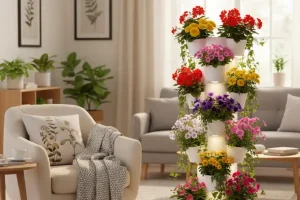Vertical vegetable gardens are efficient and rewarding, but did you know you can grow more than just food in them? By adding carefully chosen flowers alongside your vegetables, you can create a garden that is not only more colorful but also more productive. This method is called companion planting—and it works just as well in vertical gardens as it does in traditional beds.
In this article, we’ll explore the flowers that make the best companions for vertical vegetables, why they help, and how to arrange them for maximum impact.
Why Companion Planting Works
Flowers are more than decorative. When paired with vegetables, they offer real, practical benefits that fit perfectly with vertical systems. Flowers act like tiny garden helpers: they lure pollinators, confuse pests with scent, and create a healthier mini-ecosystem in a small footprint.
In tight spaces, this extra support can be the difference between a few fruits and a steady harvest.
Key benefits:
- Pollinator attraction: Flowers bring bees, butterflies, and hoverflies that boost fruit set on tomatoes, peppers, cucumbers, and strawberries.
- Pest control: Certain blooms release scents that repel or distract pests, while others host beneficial insects that hunt aphids and mites.
- Biodiversity: A mix of shapes, scents, and bloom times lowers the chances of one disease or pest wiping out a whole column.
- Aesthetic value: Vegetables and flowers together create a cheerful living wall that you’ll love looking at every day.
Great pairings for vertical gardens:
- Marigold with tomatoes or peppers to deter nematodes and leaf pests
- Nasturtium with cucumbers or kale; it trails beautifully and can serve as a trap crop for aphids
- Sweet alyssum beneath strawberries or lettuce; it draws hoverflies that eat aphids
- Calendula near brassicas for general pest distraction and easy color
- Basil and chives around tomatoes and strawberries to subtly repel pests and improve flavor in the kitchen
How to use flowers on towers:
- Place pollinator magnets at the top and edges where they’re easiest to see and access.
- Mix early, mid, and late bloomers so there’s always nectar available.
- Deadhead weekly to keep flowers coming and reduce pest hideouts.
- Keep spacing airy; cramped pockets invite mildew.
- Avoid aggressive spreaders like mint unless contained.
For vertical gardeners, the result is better yields in limited space, fewer pest problems, and a striking display that looks as good as it performs.
Best Flowers for Vertical Companion Planting
1. Marigolds
- Repel nematodes, aphids, and whiteflies.
- Bright orange and yellow blooms add color to vegetable towers.
- Great companions for tomatoes, peppers, and beans.
2. Nasturtiums
- Act as a “trap crop,” attracting aphids away from vegetables.
- Leaves and flowers are edible, adding value to your garden.
- Pair well with cucumbers, beans, and leafy greens.
3. Lavender
- Strong fragrance deters moths, fleas, and mosquitoes.
- Attracts bees for pollination.
- Works well alongside peppers and leafy greens in vertical walls.
4. Calendula (Pot Marigold)
- Repels aphids, thrips, and whiteflies.
- Attracts beneficial insects like hoverflies and ladybugs.
- Suitable companion for lettuce, kale, and spinach.
5. Sunflowers (Dwarf Varieties)
- Attract pollinators and provide vertical height contrast.
- Can act as a natural trellis for climbing beans or cucumbers.
- Compact varieties fit well into vertical systems.
6. Alyssum
- Produces tiny flowers that attract beneficial predators such as lacewings.
- Excellent ground or filler plant in vertical walls.
- Pairs well with brassicas like broccoli and kale.
Example Planting Combinations
- Tomatoes + Marigolds: Pest protection and better pollination.
- Cucumbers + Nasturtiums: Nasturtiums lure pests away.
- Lettuce + Calendula: Calendula attracts ladybugs to control aphids.
- Beans + Sunflowers: Sunflowers provide natural support while attracting bees.
Companion Planting Quick Reference Table
| Flower | Benefits | Best Vegetable Companions |
| Marigolds | Repel pests, attract pollinators | Tomatoes, peppers, beans |
| Nasturtiums | Trap pests, edible | Cucumbers, beans, greens |
| Lavender | Repels moths, attracts bees | Peppers, leafy greens |
| Calendula | Attracts ladybugs, repels pests | Lettuce, kale, spinach |
| Sunflowers | Pollinator magnet, natural trellis | Beans, cucumbers |
| Alyssum | Attracts beneficial insects | Brassicas (broccoli, kale) |
Common Mistakes to Avoid
- Overcrowding flowers and vegetables – Vertical systems need airflow to prevent pests and disease.
- Mixing plants with different water needs – Choose flowers that match your vegetables’ care requirements.
- Ignoring bloom cycles – Some flowers bloom only part of the season; stagger plantings for continuous benefit.
- Relying on flowers alone for pest control – Use them as part of an integrated approach with good maintenance.
FAQs
Q: Do companion flowers reduce vegetable yields?
No. When chosen carefully, they boost yields by attracting pollinators and repelling pests.
Q: Can I grow companion flowers indoors with vegetables?
Yes. Many shade-tolerant flowers like nasturtiums and marigolds adapt well to indoor vertical gardens with grow lights.
Q: How many flowers should I plant per tower?
Even a few companion flowers can make a difference. Aim for 10–20% of your vertical garden space.
Q: Do I need to replant flowers every season?
Annual flowers like marigolds and nasturtiums will need replanting, while perennials like lavender return year after year.
Next Steps & Related Reading
If pests are a concern, read Preventing & Treating Common Flower Pests in Vertical Beds for more defense strategies.
For purely decorative inspiration, see How to Create a Living Wall of Seasonal Blooms.
Conclusion
Companion planting is a simple yet powerful way to improve both the productivity and beauty of your vertical vegetable garden. By pairing vegetables with flowers like marigolds, nasturtiums, and calendula, you’ll attract pollinators, repel pests, and create a living wall that’s as practical as it is stunning.
Which flower would you add first to boost your vegetable yields—marigolds for pest protection, or nasturtiums for edible color?




